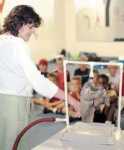Local children learn about the dangers of smoking

SIKESTON - "Ewwww! That's nasty!" chorused almost 50 youngsters at the YMCA day camp. They were looking at a damaged pig's lung, showing the dangers of tobacco use.
Brenda Freed, Health Educator at the Scott County Health Department, explained: "this is what the lung of someone who has smoked a pack of cigarettes every day for 25 years." The lung had been placed in a smoke-filled environment to obtain this effect.
Although the group of 5-to-10 year olds was young, Freed said the message they heard was important for any age group. "Anytime you have the opportunity to speak to any group of people, it is good," she said. "Awareness is what we're trying to raise."
Freed pointed out to the campers that tobacco products are all around them. What the children didn't realize, though, is that they are primary targets of cigarette advertisements.
"Most of the time, advertisements are geared toward young people, because the companies need new people to start smoking," she said. "Companies want to gain 5,000 new smokers every day to keep their sales up."
"Television! Gas stations! Magazines! Movies!" replied campers about places they had seen tobacco products advertised or used.
Freed explained that tobacco companies often pay to have their product featured in movies. "They do this so you can see people using their products," she said. Even children's movies, such as Disney's 101 Dalmatians, portray characters smoking.
Freed also showed the youngsters a magazine advertisement. From looking at the "three-piece suit" of jeans, and t-shirt and sneakers, it appeared to describe a child's outfit. After a closer look, one could see a pack of cigarettes in the t-shirt pocket.
"This ad tells you nothing about the product," Freed said. "It doesn't tell you about the toxic chemicals used or the cancers you can get."
But Freed enlightened the children. "There are more than 4,000 chemicals used in cigarettes," she said. "And most of them are poisonous."
Holding up a bottle of nail polish remover, she told them that acetone in the remover is also found in cigarettes. Other chemicals she pointed out included: arsenic in rat poison, ammonia like that used to clean toilets, butane in lighter fluid and of course, nicotine found in insecticides.
Freed also showed them a jar of tar. "This is just like the black, oily substance that you find on the streets," she explained. This tar collects in lungs and hardens.
"It clogs the air sacs. Sometimes they bust," Freed said. The air sacs never heal and are gone forever. If too many sacs burst, it may lead to emphysema.
Mr. Grossmouth, an image of an unhealthy mouth, caught the kids' eye. This model showed what tobacco use, as well as other improper care, can do to teeth and gums.
But the lung is what fascinated the kids. They wanted to look at it, touch it, and know more about it.
"Lungs are usually pink," Freed said. The ashen-colored lung was definitely damaged, and "gross" according to several campers.
The lung obviously made an effect on 7 year old Crystal Sharp. "It was disgusting," she said. "I won't smoke because then my lungs would be nasty," she said.
Freed instructed the children to carefully observe the lung as she was inflating it, like a human's lung does when breathing.
"One part's not moving!" a camper shouted out. Freed explained that this part of the lung was not expanding due to smoking and signified emphysema.
"That's why people with emphysema have a hard time breathing," she clarified. Freed told the kids that people who need air tanks to help them breathe are often victims of emphysema, a lung disease sometimes caused by smoking.
She also pointed out a spot on the lung, which represented lung cancer.
At the end of the presentation, campers were able to take a closer look at the lung, Mr. Grossmouth, and the chemicals used in cigarettes.
The children appeared to learn quite a bit. Matthew Sims, 7, said that although he had already decided not to smoke, this reinforced his decision. "My lungs would turn black," he said.
His friend James Glover, 10, agreed. "I would probably die," he said.
Children discussed telling friends and family members who smoked about what they had learned.
Freed asked the children to: "take the information you learned today with you for the rest of your life." She asked them to discuss the decision to smoke with their parents and pointed out that many who start smoking think they can stop, but the nicotine addicts them.
This fall, junior high and high school students will have the opportunity to learn about the dangers of smoking and secondhand smoke. Teens taking this course will then inform younger students, such as those at the day camp. Smokebusters, a three-year program for youth, will be implemented.
"This is the first year we've tried to emphasize the program in Southeast Missouri," Freed said.
For more information about Smokebusters, contact the Scott County Health Department at 471-4044.

